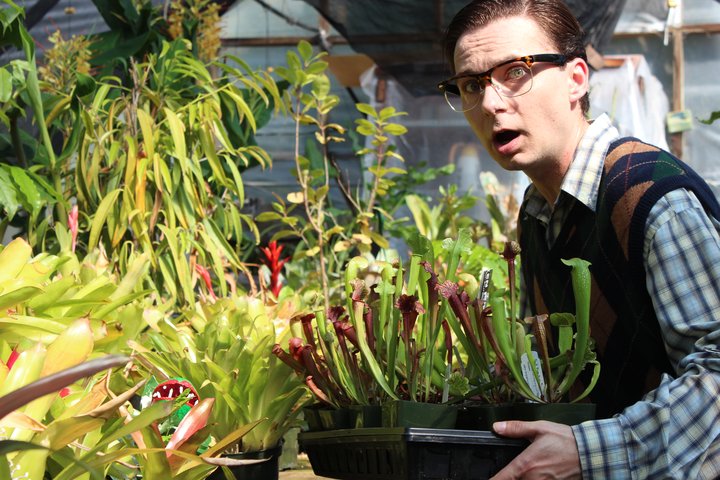
NOT-SO-SUDDENLY SEYMOUR Morgan Cox is Seymour in Ferndale Rep’s Little Shop of Horrors, a role he has wanted to play since age 9, when his father took him to his first live theater, a production of Little Shop of Horrors. Photo by Alexandra Blouin.
Center stage, a pink hippo and a mermaid sing through the
alphabet. The pair are cast members of Ferndale Repertory Theatre’s
newest production, Alan Menken and Howard Ashman’s rock musical
Little Shop of Horrors, which opens today. If you don’t recall either a hippo or a mermaid in
the horror-comedy, there’s no need to question reality — dress
rehearsals were yet to come, so on this particular day, some of the
cast elected to come to rehearsal in footie jammies. They’re
running through their vocal warm-ups.
Last Wednesday, Sept. 20 was the hump day of tech rehearsal week (aka “Hell Week,” according to accompanist Laura Welch) and the cast and crew are finally getting onstage, after weeks of rehearsing at a church. The cast runs – or, rather, walks – through the second act as lighting designer Michael Foster and team program the light cues. Actors are getting to handle their props for the first time and perform their scenes on the set, some of which is still under construction.
Director/Choreographer Alexandra Blouin is finally getting to see what works and what doesn’t, and is making changes large and small. Artistic Producing Director Leira Satlof is on hand too, seemingly everywhere at once, repeatedly asking everyone not to step on the metal tracking installed in the aisles (prior to putting down carpeting), taking a critical look at everything, making concise suggestions for improvements and graciously showing around a stage-struck reporter.
It’s chaos, but it’s an organized chaos.
Besides pulling together a show, the folks of the Ferndale Rep, “the little theatre that could,” are also in the midst of a remodel. The lobby has been expanded, with some of the far back seating removed. The concessions area is coming together. The swanky new seats (complete with cupholders!) are installed. Like Satlof, Carl McGahan is also everywhere, splitting his time between building permanent fixtures, constructing a prop refrigerator and working out issues with trapdoors and puppets. By the time you read this, the Ferndale Rep will be a plush, comfy modern theatre, the set will have a snazzy fake fridge and a trapdoor may have rounded edges that you will never see.
There are technological improvements too. The crew are equipped with new headsets, allowing those in the back of the house to communicate with those out front. It’s a new experience for veteran accompanist Welch, who has to get used to hearing voices in one ear while playing the keyboard. Because the band is backstage in this production, she can see the stage only through a narrow opening. No worries; she also has a new flatscreen monitor linked to a camera, which will give her a view of the entire stage. At the moment, though, the picture is very fuzzy, an impressionistic blur of blues and oranges. Satlof and I move out of the way so that techs can, literally, focus.
It’s technology in the service of magic.
For those unfamiliar with the show, Little Shop of Horrors, based on a low-budget comedy/horror Roger Corman film, is a musical about Seymour (played by Morgan Cox) a Skid Row floral assistant who discovers an exotic bloodthirsty plant, which he names Audrey II after his crush, Audrey (Jessica Kaufman). Soon, Seymour finds himself fly-trapped into making one bad decision after another as the ever-growing plant brings him fame and fortune, while demanding ever fresher and larger servings of human flesh.
At this particular rehearsal, the cast is running through Act II, in which the plant is fully grown and the flower business is booming. The act opens with a music number, “Call Back in the Morning,” a seemingly chaotic, yet tightly choreographed flurry of activity: shop assistants run to and fro, Mushnik (Warren Hardison), Seymour and Audrey struggle to keep up with orders and the phones are ringing off the hook.
The ringing phones present a technical challenge. Sound designer Dillon Savage has to time them properly, so that a ring precedes each actor picking up a receiver. The play is set in the 1960s, so the phones are old-school rotary landlines. There’s a bit of a learning curve here: Blouin half-jokingly explains to the actors – some of whom are millennials who admit to never having used such a phone – that putting someone on hold requires laying the receiver down, not back into its cradle. “You’ve just hung up on them,” she explains. “What are the spinny things on the phones for?” quips one of the cast members.
The actors patiently run through the sequence over and over. When Blouin or one of the tech crew call out “Hold,” everyone immediately stops what they’re doing. They then wait patiently as new directions are issued, try out variations on their choreography and blocking, reset and pick up the action from a cued line. They watch Blouin act out different ways to place the phone receivers, suggest some of their own, and finally make it work. There’s a lot to go through here, conclude Blouin and Satlof, so they schedule a “special,” a rehearsal specifically for this number.
Without transitions, the cast runs through number after number. Dell’Arte alum Lucius Robinson (who plays sadistic Orin Scrivello, DDS in Act I) runs through a scene in which he plays a number of characters enticing Seymour to sign contracts. In the production, he will rapidly change costumes, but for now he’s in street clothes. As he emerges in his second character, Satlof, walking by, whispers to me, “He’ll be dressed like a woman now,” but Robinson’s falsetto had already clued me in on that. As they run through the scene again and again, Cox and Robinson hit the same cues and deliver their lines perfectly despite multiple interruptions and distractions. They make it look easy, but only because they, like the rest of the cast, have already clearly put in a lot of hard work.
Then the group moves along to the next scene and the next, keeping at it for well over three hours, just this one evening.
Puppeteer Jeff Cooper spends most of that time encased in the giant foam rubber Audrey II puppet rented for the play. For some of that time, Cooper stands, supporting the weight of the puppet and holding up its lower part with his arms. When the puppet moves and speaks, he uses his whole body to move the apparatus, making the plant’s lips sync with its voice, provided offstage by Craig Woods. When Audrey II is at rest, he even makes the puppet “breathe.” It’s a masterful performance from someone you can easily forget is onstage the whole time.
It’s hot in there though. Cooper wears a T-shirt with large pockets sewn on; these hold ice packs to keep him from overheating. Blouin conscientiously calls for Cooper to emerge from the puppet every moment he’s not required to perform. Still, halfway through the evening, his ice packs have already completely melted. Satlof makes a note to get a second set.
The rehearsal progresses in a roughly chronological order, so the group runs through the climactic “Sominex/Suppertime II” number a couple of times. There’s an issue, though: “urchins” Crystal (Stevy Marquez), Ronette (Emma Johnstone) and Chiffon (Jessie Rawson) are standing center stage, blocking the action. Blouin has them move stage left, arranging them on the staircase there. Now, we can better see Seymour’s realization that all he loves is lost. Even without costumes, in rehearsal and out of context, actor Morgan Cox delivers such a powerfully emotional moment that I find myself with two fat tears running down my cheeks. I can only imagine how moving it will be when it’s all put together.
Toward the end of rehearsal, the cast runs through the closing sequence. The urchins are to pick leaves from Audrey II to propagate the plant, so the actors mime the action. “Where are the leaves?” asks Satlof. Prop leaves are produced, and, after some discussion, placed on the floor by the plant. The actors run through the sequence again, picking the leaves and putting them in pots. Satlof makes a note to get some florist’s foam. Set designer Cecilia Beaton magically produces some from her bag. And the show goes on.
There’s still so much to do, nine days out from opening night. The analog wall clock on set, for example, has to be rigged to actually read six o’clock by the end of “Call Back in the Morning.” It may seem like a trivial thing, but it’s details like these that add polish to a show.
And with this much polish, Ferndale Rep’s Little Shop of Horrors promises to be quite a gem.
Little Shop of Horrors runs at the Ferndale Repertory Theatre, 447 Main St., from Sept. 29 through Oct. 29 Fridays and Saturdays at 8 p.m. and Sundays at 2 p.m. Order tickets online at FerndaleRep.org, by calling the box office at (707) 786- 5483 and at the door beginning 30 minutes before curtain time.
###
Lauraine Leblanc is scene editor of the Mad River Union. Subscribe here.

CLICK TO MANAGE